Distribution of Residual Stresses in Dissimilar Ferritic Steel Weld Joints and Their Modification via Mechanical Hammer Peening
Abstract
1. Introduction
2. Experimental Procedure
2.1. MAG Welding Experiment
2.2. Measurement of Welding Thermal Cycles
2.3. Hammer Peening Experiments
2.4. Residual Stress Measurements
3. Numerical Procedure
- Thermal conductivity was artificially increased to simulate the convective stirring effect of fluid flow in the weld pool (above 1500 °C). This was also referred to as effective heat conductivity based on the thermo-capillary flow or the Marangoni effect [36].
- The solidus temperature of 1450 °C was used to validate the geometry of the weld.
- Boundary conditions were consistent with those in the experiments. That is, being in a free state during the MAG welding process does not affect the deformation and rigid slip of the sheet material; whereas, the model is completely fixed during the impact treatment process, as shown in Figure 4.
- BM and WM obey the Von-Mises yield criterion, and isotropic hardening was considered based on elastic–plastic material with rate-independent behavior.
3.1. Thermal Analysis
3.2. Mechanical Analysis
3.3. Peening Treatment Analysis
4. Results and Discussion
4.1. Welding Thermal Analysis
4.2. Welding Residual Stress Analysis
4.3. Effect of Hammer Peening Treatment on Residual Stress
4.4. Effect of Peening Velocity
4.5. Effect of Hammer Head Diameter
4.6. Effect of Pitch Distance
5. Conclusions
- The results of the finite element analysis are consistent with the measurements obtained using XRD, and the validity of the finite element model is fully verified.
- The residual stress in longitudinal and transverse components is mainly tensile. Lateral residual stress, on the other hand, exhibits the opposite trend due to different cooling shrinkage effects. Overall, longitudinal residual stresses dominate in welds and heat-affected zones. The difference in strength results in different equivalent stress gradients on both sides of the fusion zone.
- After hammering treatment, the residual stress in the welding area is significantly reduced, with a maximum elimination rate of about 62%. The finite element analysis results indicate that hammering technology has significant effects on controlling residual stresses after welding.
- When the hammering speed and pitch are fixed, the change in the hammering diameter results in the most significant change in residual stress after hammering treatment.
Author Contributions
Funding
Data Availability Statement
Conflicts of Interest
References
- Li, X.H. New Low Alloy High Strength Steel Welding Procedure Evaluation. Key Eng. Mater. 2019, 814, 238–241. [Google Scholar] [CrossRef]
- Liu, J.-Z.; Chen, S.; Chan, T.-M. Experimental and numerical investigations of hybrid high strength steel welded T-section stub columns with Q690 flange and Q460 web. Thin-Walled Struct. 2022, 177, 65–89. [Google Scholar] [CrossRef]
- Chen, Q.; Yang, J.; Liu, X.; Tang, J.; Huang, B. Effect of the groove type when considering a thermometallurgical-mechanical model of the welding residual stress and deformation in an S355JR-316L dissimilar welded joint. J. Manuf. Process. 2019, 45, 290–303. [Google Scholar] [CrossRef]
- Zhang, K.; Dong, W.; Lu, S. Finite element and experiment analysis of welding residual stress in S355J2 steel considering the bainite transformation. J. Manuf. Process. 2021, 62, 80–89. [Google Scholar] [CrossRef]
- Yan, R.; Yu, Z.; Wang, S.; Liu, J. Influence of welding residual stress on bending resistance of hollow spherical joints. J. Constr. Steel Res. 2023, 208, 108004. [Google Scholar] [CrossRef]
- Luo, Y.; Gu, W.; Peng, W.; Jin, Q.; Qin, Q.; Yi, C. A Study on Microstructure, Residual Stresses and Stress Corrosion Cracking of Repair Welding on 304 Stainless Steel: Part I-Effects of Heat Input. Materials 2020, 13, 2416. [Google Scholar] [CrossRef]
- Webster, G.A.; Ezeilo, A.N. Residual stress distributions and their influence on fatigue lifetimes. Int. J. Fatigue 2001, 23, 375–383. [Google Scholar] [CrossRef]
- Zhang, W.; Jiang, W.; Zhao, X.; Tu, S.-T. Fatigue life of a dissimilar welded joint considering the weld residual stress: Experimental and finite element simulation. Int. J. Fatigue 2018, 109, 182–190. [Google Scholar] [CrossRef]
- Guo, J.; Fu, H.; Pan, B.; Kang, R. Recent progress of residual stress measurement methods: A review. Chin. J. Aeronaut. 2021, 34, 54–78. [Google Scholar] [CrossRef]
- Lee, C.-H.; Chang, K.-H. Temperature fields and residual stress distributions in dissimilar steel butt welds between carbon and stainless steels. Appl. Therm. Eng. 2012, 45–46, 33–41. [Google Scholar] [CrossRef]
- Bajpei, T.; Chelladurai, H.; Ansari, M.Z. Experimental investigation and numerical analyses of residual stresses and distortions in GMA welding of thin dissimilar AA5052-AA6061 plates. J. Manuf. Process. 2017, 25, 340–350. [Google Scholar] [CrossRef]
- Ranjbarnodeh, E.; Serajzadeh, S.; Kokabi, A.H.; Fischer, A. Effect of welding parameters on residual stresses in dissimilar joint of stainless steel to carbon steel. J. Mater. Sci. 2011, 46, 3225–3232. [Google Scholar] [CrossRef]
- Lee, C.; Chang, K. Numerical investigation of the residual stresses in strength-mismatched dissimilar steel butt welds. J. Strain Anal. Eng. Des. 2008, 43, 55–66. [Google Scholar] [CrossRef]
- Coules, H.E. Contemporary approaches to reducing weld induced residual stress. Mater. Sci. Technol. 2013, 29, 75–86. [Google Scholar] [CrossRef]
- Quan, G.; Shi, R.; Liu, Q.; Zhao, J.; Zhou, J.; Wang, Y. Analysis and elimination of residual stress in arc fuse single layer and single channel volume. Mater. Rev. 2020, 34, 1–15. (In Chinese) [Google Scholar]
- Miki, C.; Tai, M. Fatigue strength improvement by hammer peening treatment—Verification from plastic deformation, residual stress, and fatigue crack propagation rate. Weld. World 2014, 58, 307–318. [Google Scholar] [CrossRef]
- Curtat, J.L.; Lanteigne, J.; Champliaud, H.; Liu, Z.; Lévesque, J.-B. Influence of hammer peening on fatigue life of E309L steel used for 13%Cr-4%Ni blade runner repairs. Int. J. Fatigue 2017, 100, 68–77. [Google Scholar] [CrossRef]
- Simoneau, M.R.; Thibault, M.D.; Fihey, J.L. A comparison of residual stress in hammer-peened, multi-pass steel welds-A513 (S690Q) and S41500. Weld. World 2009, 53, 124–134. [Google Scholar] [CrossRef]
- Hacini, L.; Van Lê, N.; Bocher, P. Effect of impact energy on residual stresses induced by hammer peening of 304L plates. J. Mater. Process. Technol. 2008, 208, 542–548. [Google Scholar] [CrossRef]
- Chan, W.L.; Cheng, K.F. Hammer peening technology—The past, present, and future. Int J Adv Manuf Tech 2022, 118, 683–701. [Google Scholar] [CrossRef]
- GB/T3077-2015; Standard for Alloy Structure Steels. Standards Press of China: Beijing, China, 2015.
- Zhang, Y.T. Research on Organization Regulation and Mechanical Behavior of Q390/Q690 Dissimilar Welded Joints. Master’s Thesis, Northeastern University, Shenyang, China, 2021. [Google Scholar]
- Zhang, Y.; Lan, L.; Shao, G. Influence of Strength Mismatch on Microstructural Evolution and Mechanical Behaviors for Q390/Q690 Ferritic Steel Dissimilar Welded Joints. Steel Res. Int. 2022, 93, 2100592. [Google Scholar] [CrossRef]
- GB/T 985.1-2008; Standard for Recommended Bevels for Gas Welding, Electrode Arc Welding, Gas Shielded Welding and High Energy Beam Welding. Standards Press of China: Beijing, China, 2019.
- Sattari-Far, I.; Farahani, M.R. Effect of the weld groove shape and pass number on residual stresses in butt-welded pipes. Int. J. Press. Vessel. Pip. 2009, 86, 723–731. [Google Scholar] [CrossRef]
- Jiang, B.; Li, Z.; Chen, Q. Influence of bevel angle on the welding-induced residual stress and distortion based on a thermometallurgical-mechanical model in a Q345-316L dissimilar butt welded joint. J. Adhes. Sci. Technol. 2021, 35, 2249–2273. [Google Scholar] [CrossRef]
- Schulze, V.; Bleicher, F.; Groche, P.; Guo, Y.B.; Pyun, Y.S. Surface modification by machine hammer peening and burnishing. CIRP Ann. Manuf. Technol. 2016, 65, 809–832. [Google Scholar] [CrossRef]
- Lan, L.; Niu, H.; Cui, Y.; Chen, X. Local shape adjustment and residual stresses of integrally stiffened panel induced by mechanical hammer peening. J. Manuf. Process. 2023, 91, 99–109. [Google Scholar] [CrossRef]
- Niu, H. Simulation and Experimental Study on Hammering and Deformation of High Reinforcement Monolithic Wall Plate in Grid Format. Master’s Thesis, Northeastern University, Shenyang, China, 2022. [Google Scholar]
- Lin, J.; Ma, N.; Lei, Y.; Murakawa, H. Measurement of residual stress in arc welded lap joints by cosα X-ray diffraction method. J. Mater. Process. Technol. 2016, 243, 387–394. [Google Scholar] [CrossRef]
- GB/T 7704-2017; Standard for the Determination Method of Non-Destructive Testing X-Ray Stress. Standards Press of China: Beijing, China, 2017.
- Atluri, S.N. Finite element-perturbation analysis of nonlinear dynamic response of elastic continua. Finite Elem. Methods Eng. 2023, 11, 581–595. [Google Scholar]
- Wang, F.J. Contact force algorithm in explicit transient analysis using finite-element method. Finite Elem. Anal. Des. 2007, 43, 580–587. [Google Scholar] [CrossRef]
- Meena, P.; Anant, R. On the Interaction to Thermal Cycle Curve and Numerous Theories of Failure Criteria for Weld-Induced Residual Stresses in AISI304 Steel using Element Birth and Death Technique. J. Mater. Eng. Performance 2024, 33, 2024–2279. [Google Scholar] [CrossRef]
- Qiang, X.H.; Bijlaard, F.; Kolstein, H. Dependence of mechanical properties of high strength steel S690 on elevated temperatures. Constr. Build. Mater. 2012, 30, 73–79. [Google Scholar] [CrossRef]
- Xu, Q.F. Deterioration of mechanical properties of high strength structural steel S460N under steady state fire condition. Mater. Des. 2012, 100, 116–122. [Google Scholar]
- Mehran, G.; Joseph, A.; Juho, M.; Timo, B.; Jari, L. Finite element simulation of welding distortions in ultra-high strength steel S960 MC including comprehensive thermal and solid-state phase transformation models. Eng. Struct. 2020, 219, 110804. [Google Scholar]
- Chang, K.-H.; Lee, C.-H.; Park, K.-T.; Um, T.-H. Experimental and numerical investigations on residual stresses in a multi-pass butt-welded high strength SM570-TMCP steel plate. Int. J. Steel Struct. 2011, 11, 315–324. [Google Scholar] [CrossRef]
- Taljat, B.; Radhakrishnan, B.; Zacharia, T. Numerical analysis of GTA welding process with emphasis on post-solidification phase transformation effects on residual stresses. Mater. Sci. Eng. A 1998, 246, 45–54. [Google Scholar] [CrossRef]
- Incropera, F.; Dewitt, D.; Bergman, T.; Lavine, A. Fundamentals of Heat and Mass Transfer; John Wiley & Sons Inc.: Chichester, UK, 2007; Volume 71–72, pp. 571–583. [Google Scholar]
- Deng, D.; Kiyoshima, S. Numerical simulation of welding temperature field, residual stress and deformation induced by electro slag welding. Comp. Mater. Sci. 2012, 62, 23–24. [Google Scholar] [CrossRef]
- Goldak, J.; Chakravarti, A.; Bibby, M. A new finite element model for welding heat sources. Metall. Trans. B 1984, 15, 299–305. [Google Scholar] [CrossRef]
- Cai, X.; Lin, S.; Cheng, Y.; Yang, D.; Yang, C.; Fan, C. The effects of double groove type on the backing weld penetration in swing arc vertical-up MAG welding. Weld. World 2019, 28, 75–86. [Google Scholar] [CrossRef]
- Taraphdar, P.K.; Mahapatra, M.M.; Pradhan, A.K.; Singh, P.K.; Sharma, K.; Kumar, S. Effects of groove configuration and buttering layer on the through-thickness residual stress distribution in dissimilar welds. Int. J. Press. Vessel. Pip. 2021, 192, 104392. [Google Scholar] [CrossRef]
- Zhu, H.; Zhang, C.; Chen, S.; Wu, J. A modified Johnson-Cook constitutive model for structural steel after cooling from high temperature. Constr. Build. Mater. 2022, 340, 127746. [Google Scholar] [CrossRef]
- Cadoni, E.; Forni, D. Strain-rate effects on S690QL high strength steel under tensile loading. J. Constr. Steel Res. 2020, 175, 106348. [Google Scholar] [CrossRef]
- Liu, Q.; Chen, S.; Xu, X.; Jin, S.; Li, Y.; Wang, Y.; Shen, B. Multi-objective optimization of the subsurface residual stress field of TC4 alloy in machine hammer peening. J. Manuf. Process. 2023, 104, 98–107. [Google Scholar] [CrossRef]
- Sun, J.; Nitschke-Pagel, T.; Dilger, K. Generation and distribution mechanism of welding-induced residual stresses. J. Mater. Res. Technol. 2023, 27, 3936–3954. [Google Scholar] [CrossRef]
- Ma, N.; Ueda, Y.; Murakawa, H. Welding Deformation and Residual Stress Prevention; Butterworth-Heinemann: Oxford, UK, 2012; Volume 46, pp. 169–207. [Google Scholar]
- Huang, B.; Liu, J.; Zhang, S.; Chen, Q.; Chen, L. Effect of post-weld heat treatment on the residual stress and deformation of 20/0Cr18Ni9 dissimilar metal welded joint by experiments and simulations. J. Mater. Res. Technol. 2020, 9, 6186–6200. [Google Scholar] [CrossRef]
- Cai, J.P.; Ye, Y.H.; Zhang, Y.J.; Deng, D. Effect of bevel form on residual stress and deformation in Q345/SUS304 dissimilar steel butt joints. J. Mech. Eng. 2015, 51, 7–13. [Google Scholar] [CrossRef]
- Zhu, S.-P.; Ye, W.-L.; Correia, J.A.F.O.; Jesus, A.M.P.; Wang, Q. Stress gradient effect in metal fatigue: Review and solutions. Theor. Appl. Fract. Mech. 2022, 121, 103513. [Google Scholar] [CrossRef]
- Gates, N.; Fatemi, A. Notch deformation and stress gradient effects in multiaxial fatigue. Theor. Appl. Fract. Mech. 2016, 84, 3–25. [Google Scholar] [CrossRef]
- Ma, G.; Zhang, L.; Wang, C.; Liu, X.; Meng, Q. Effect of Ultrasonic Impact Treatment on Residual Stress and Fatigue Properties of Q345 Welded Joints. IOP Conf. Ser. Mater. Sci. Eng. 2018, 452, 67–79. [Google Scholar] [CrossRef]
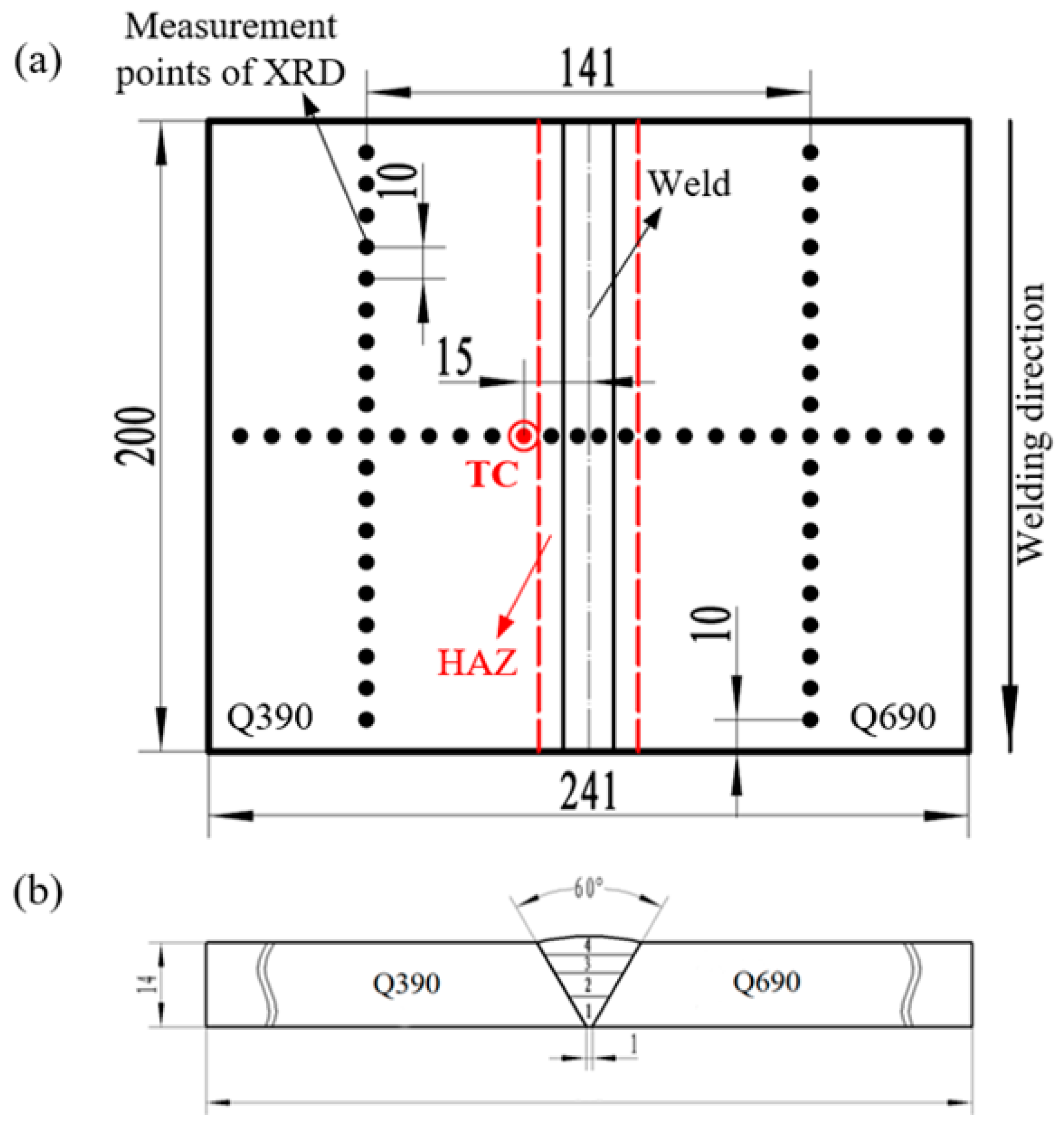

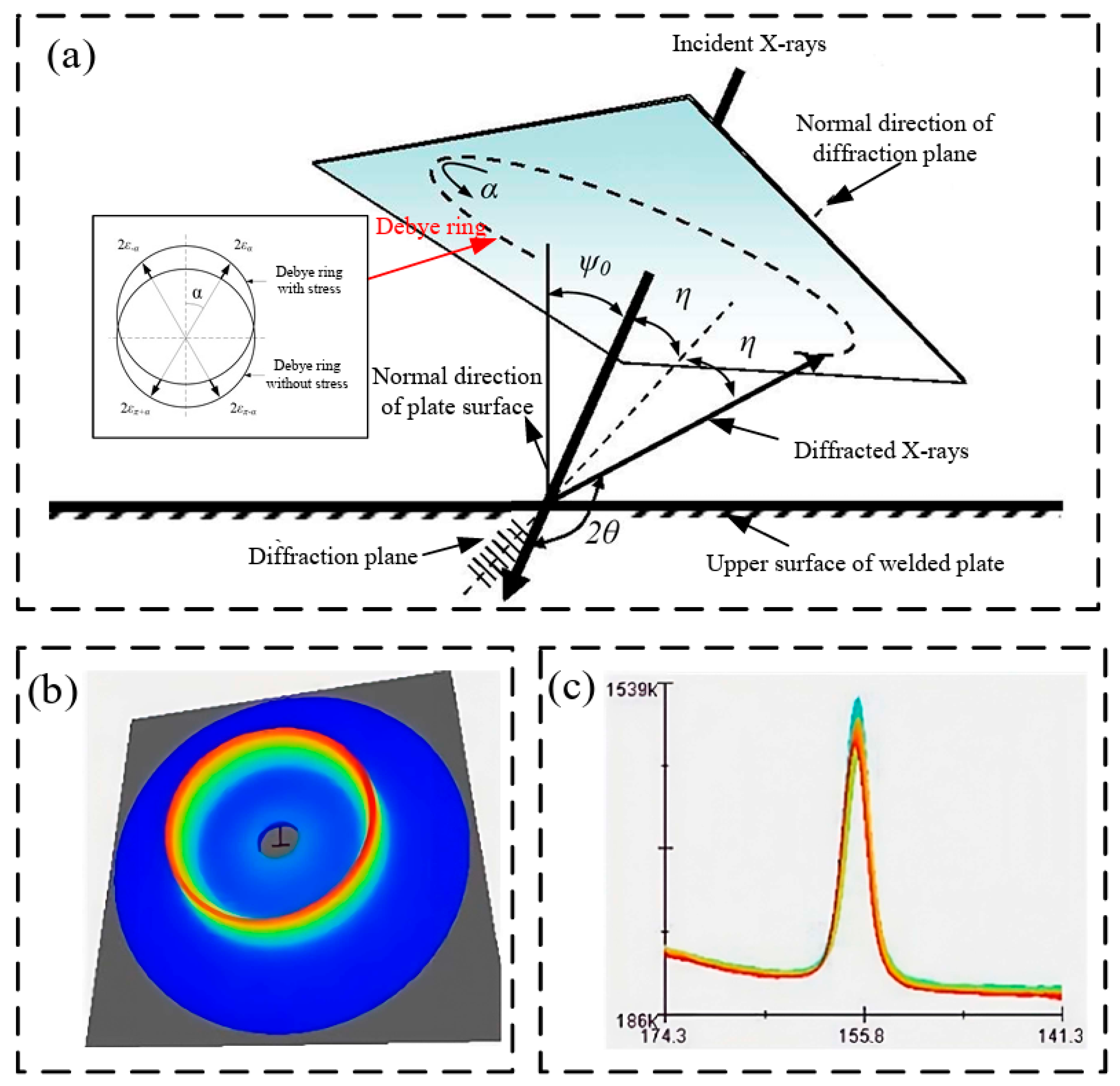
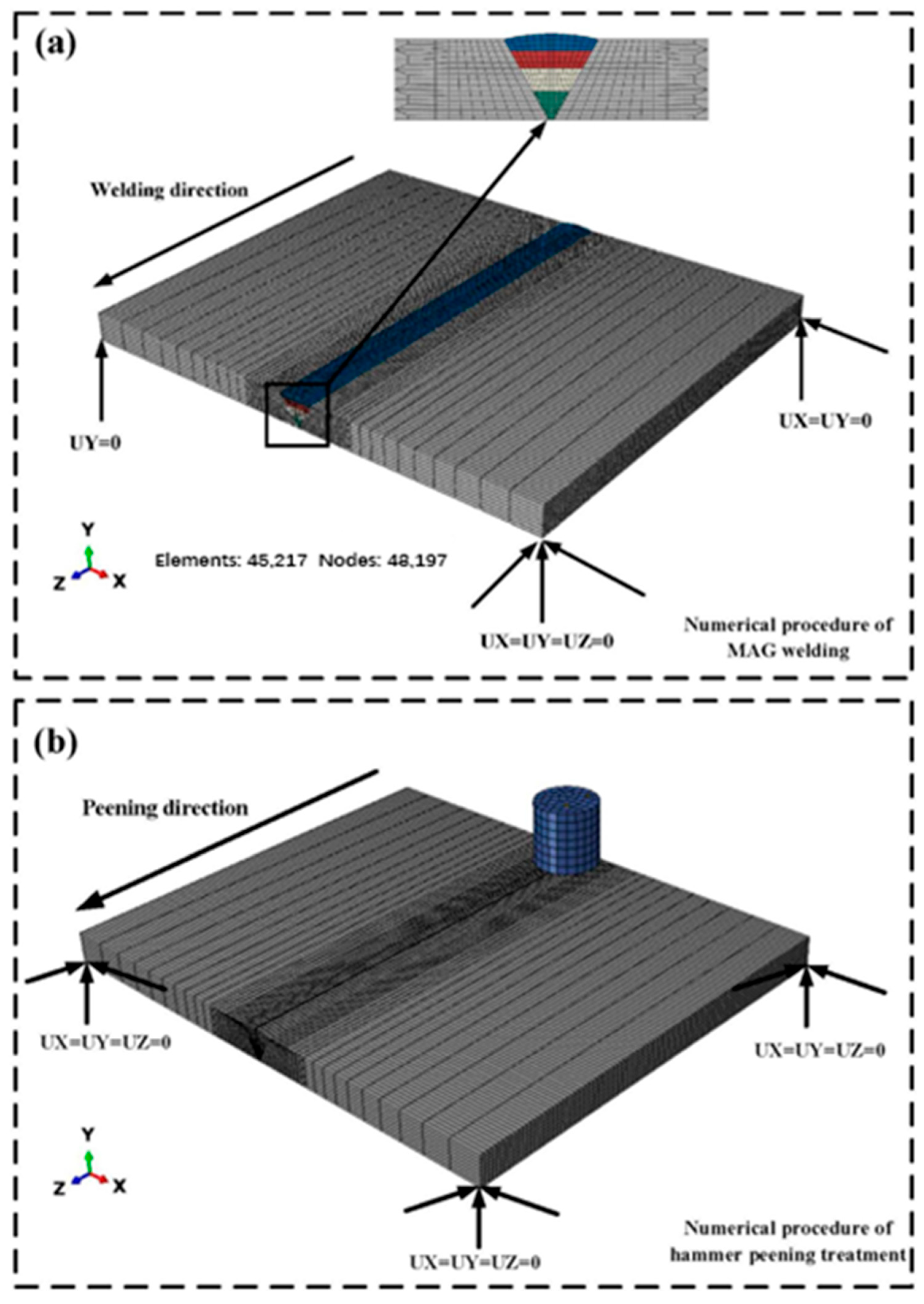

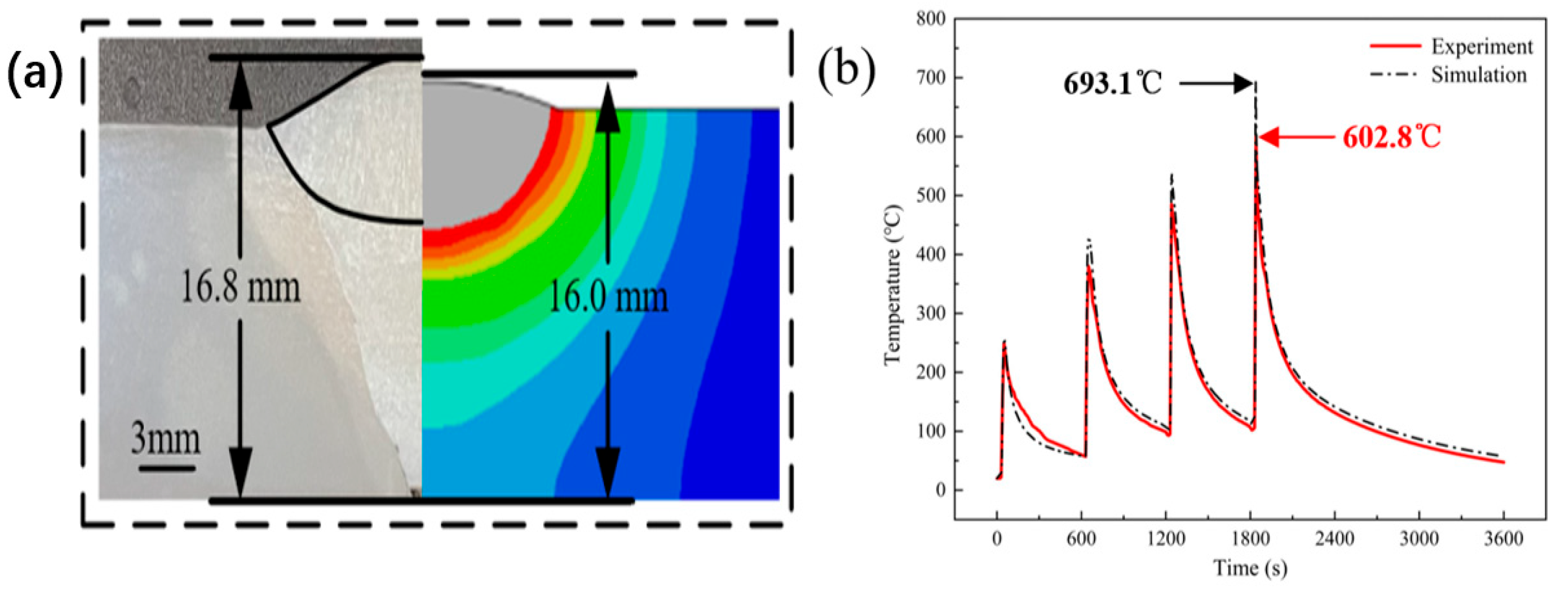
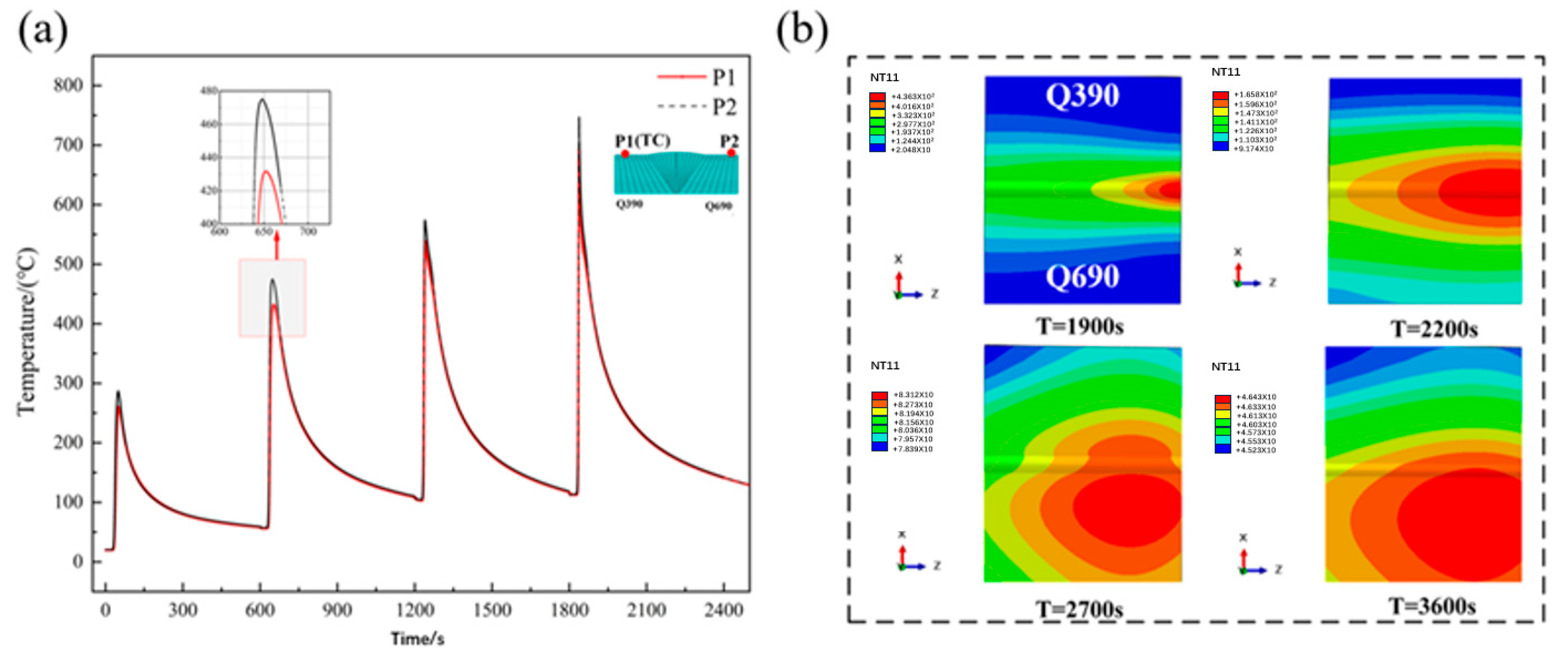
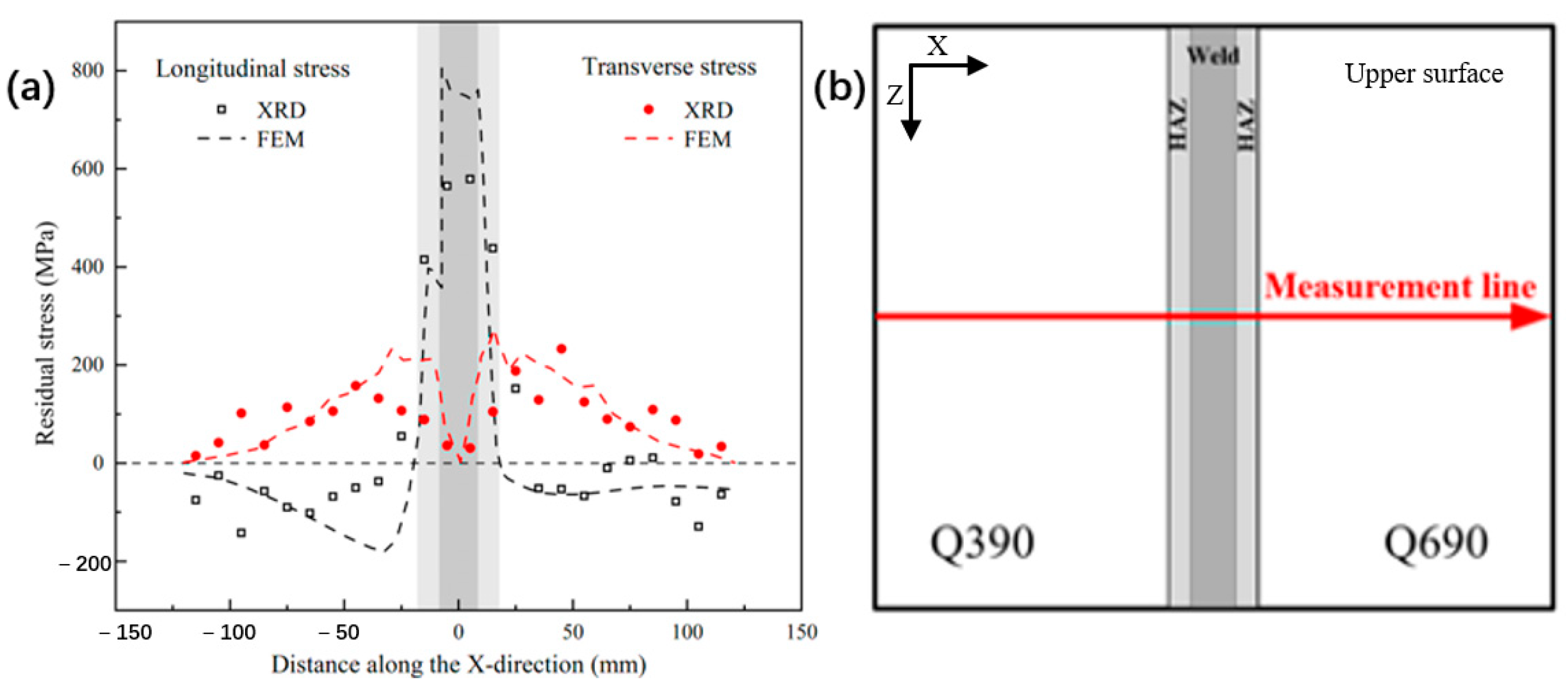

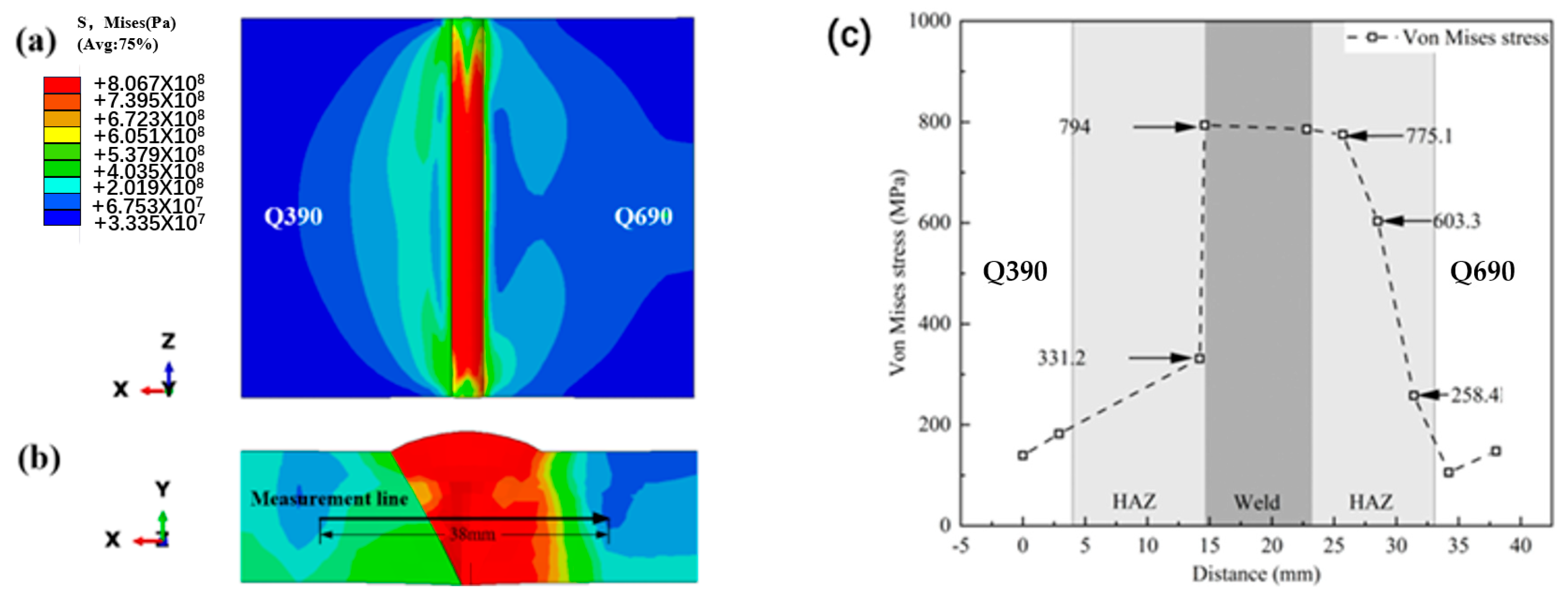
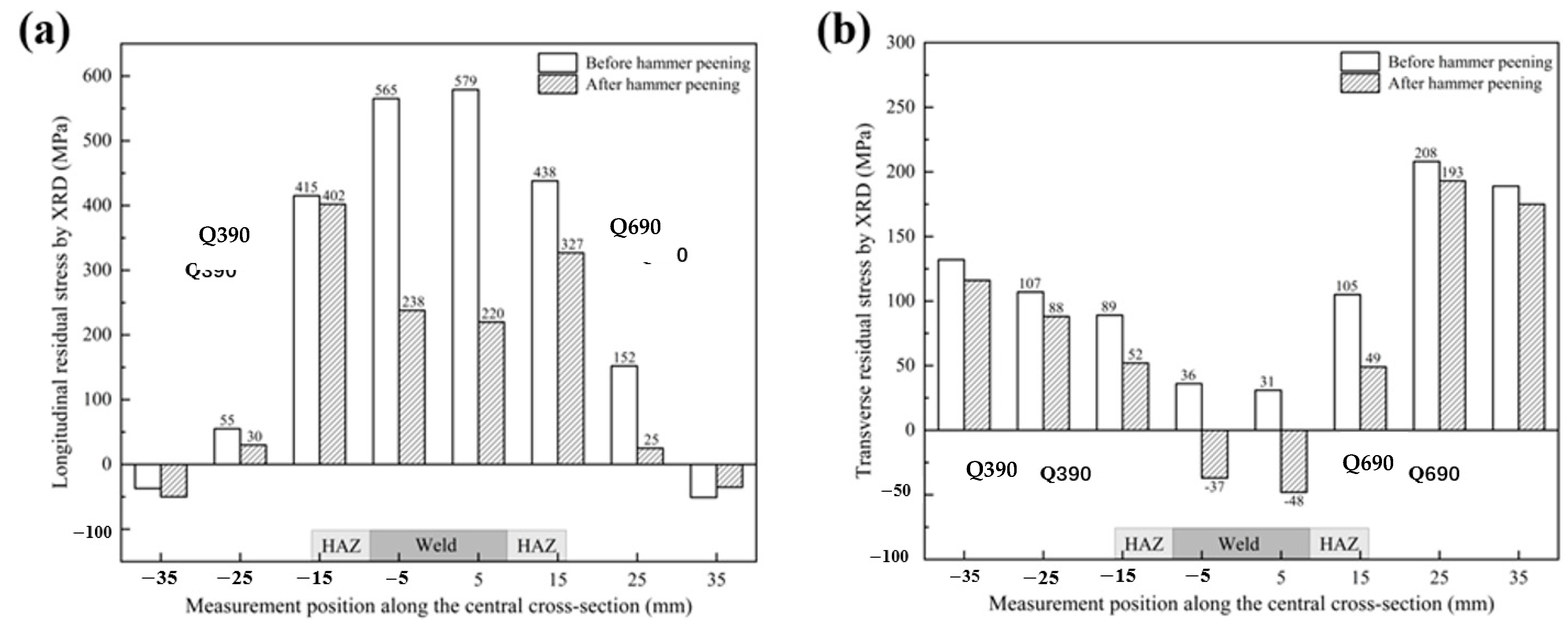
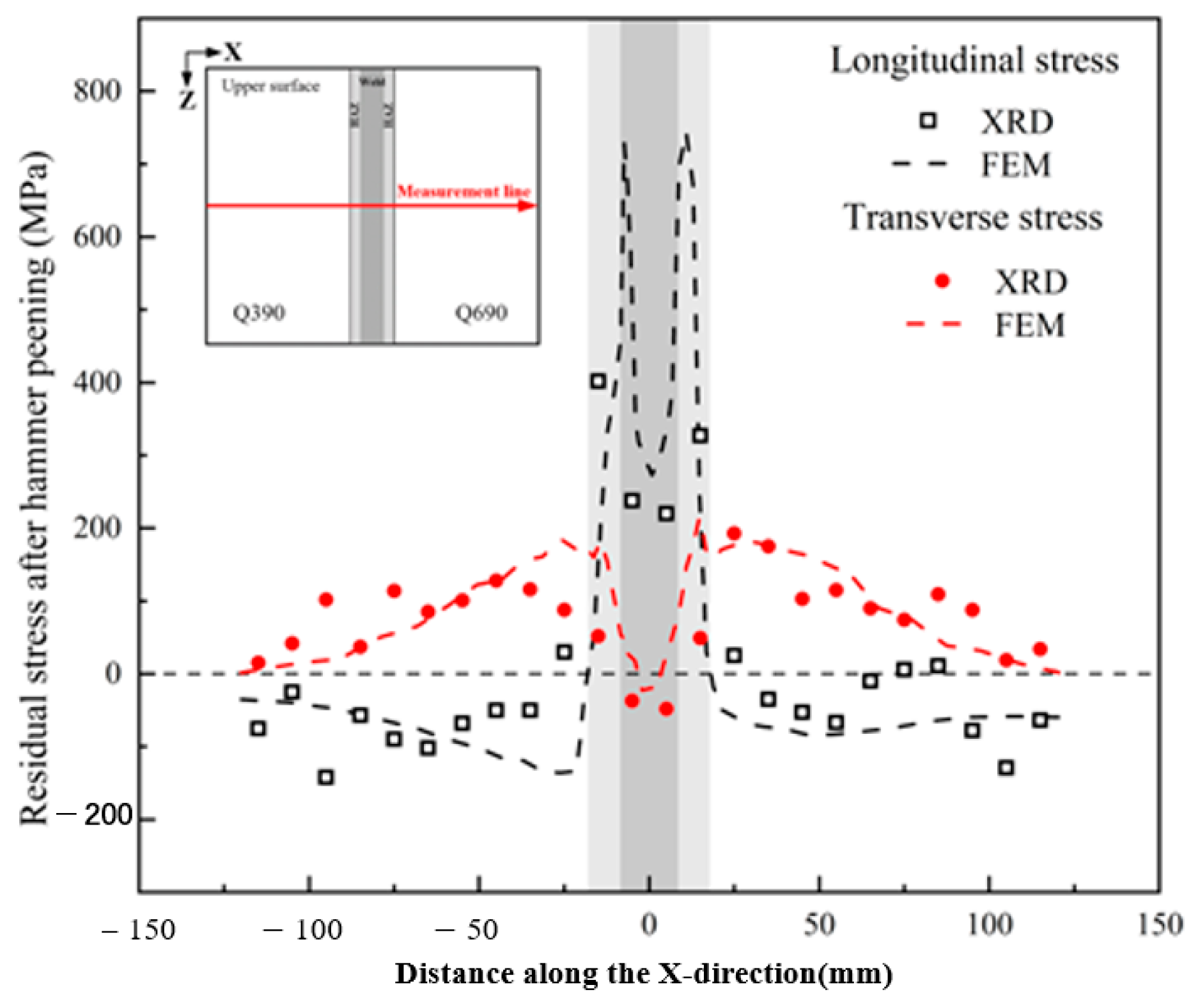
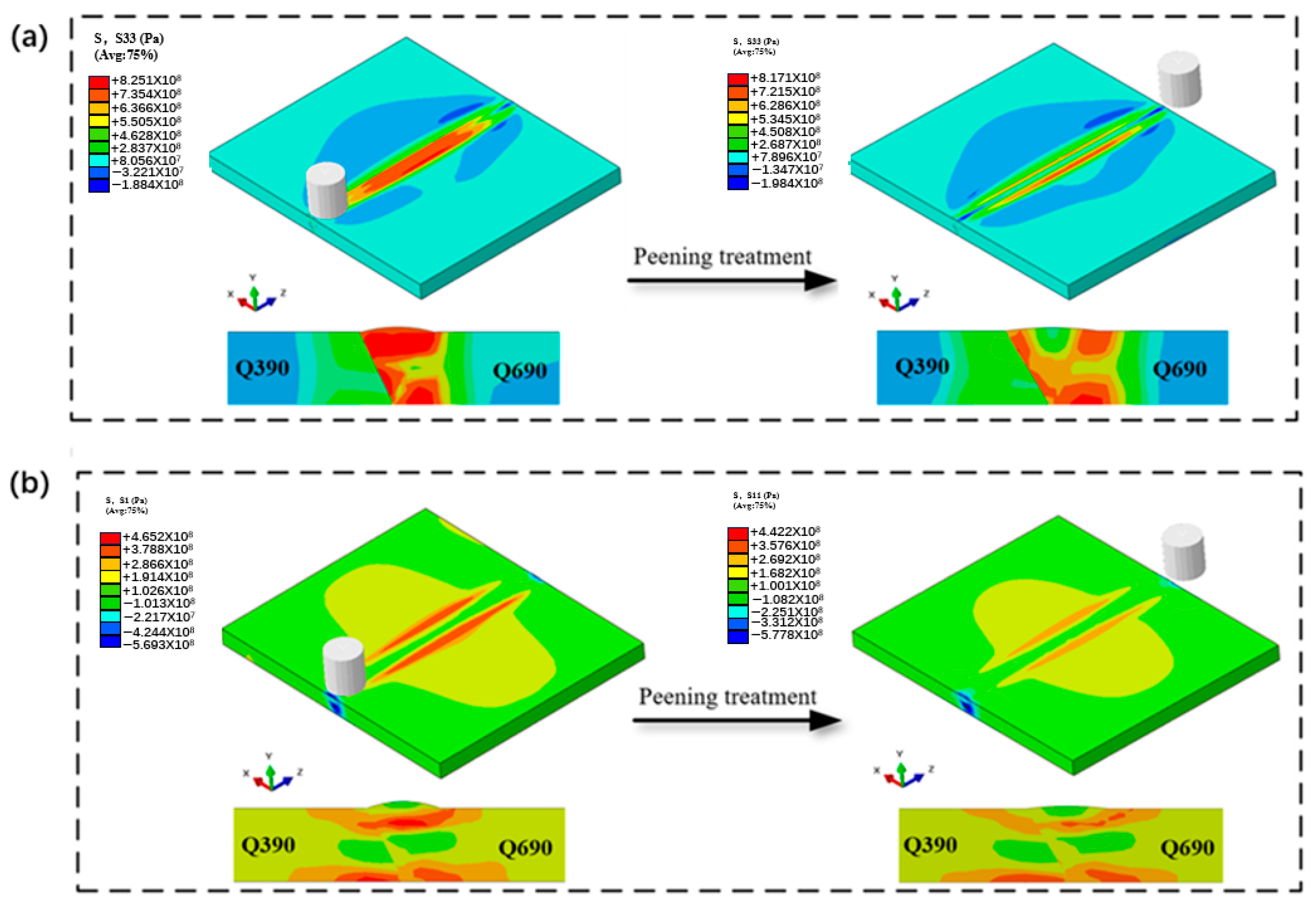

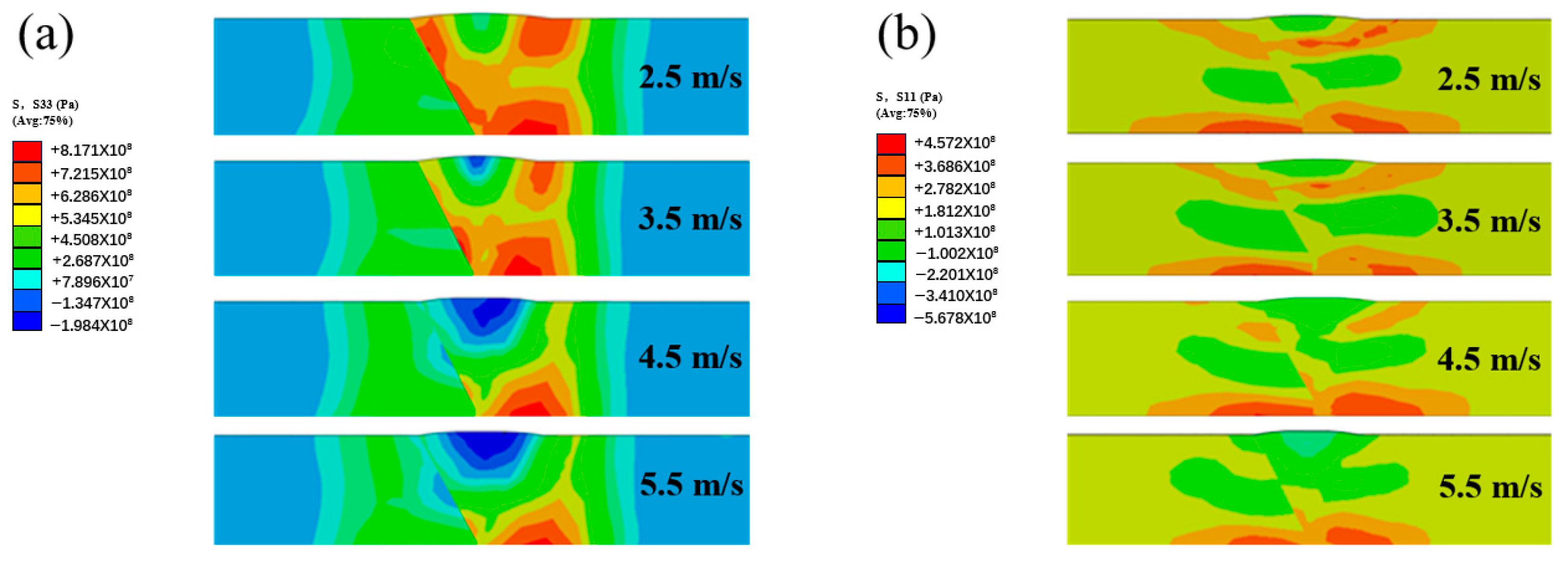
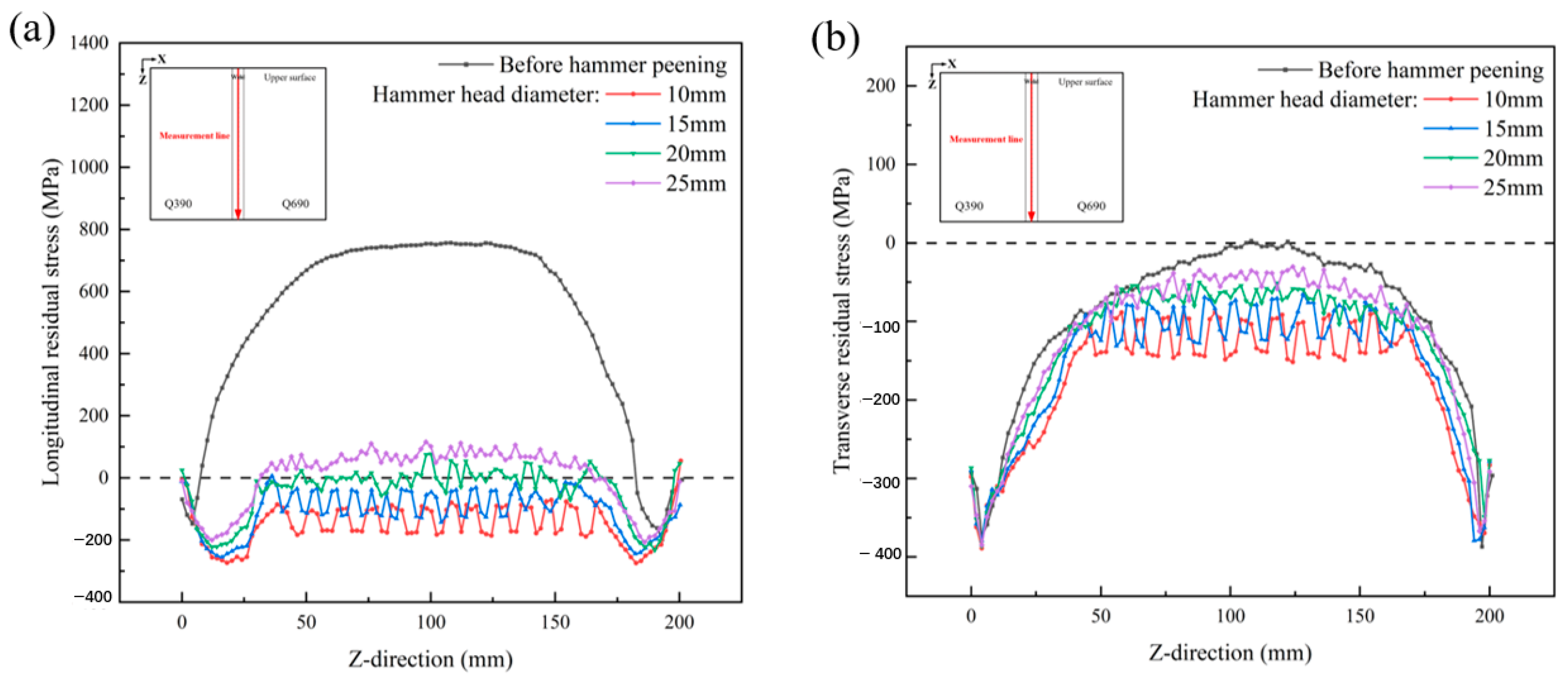

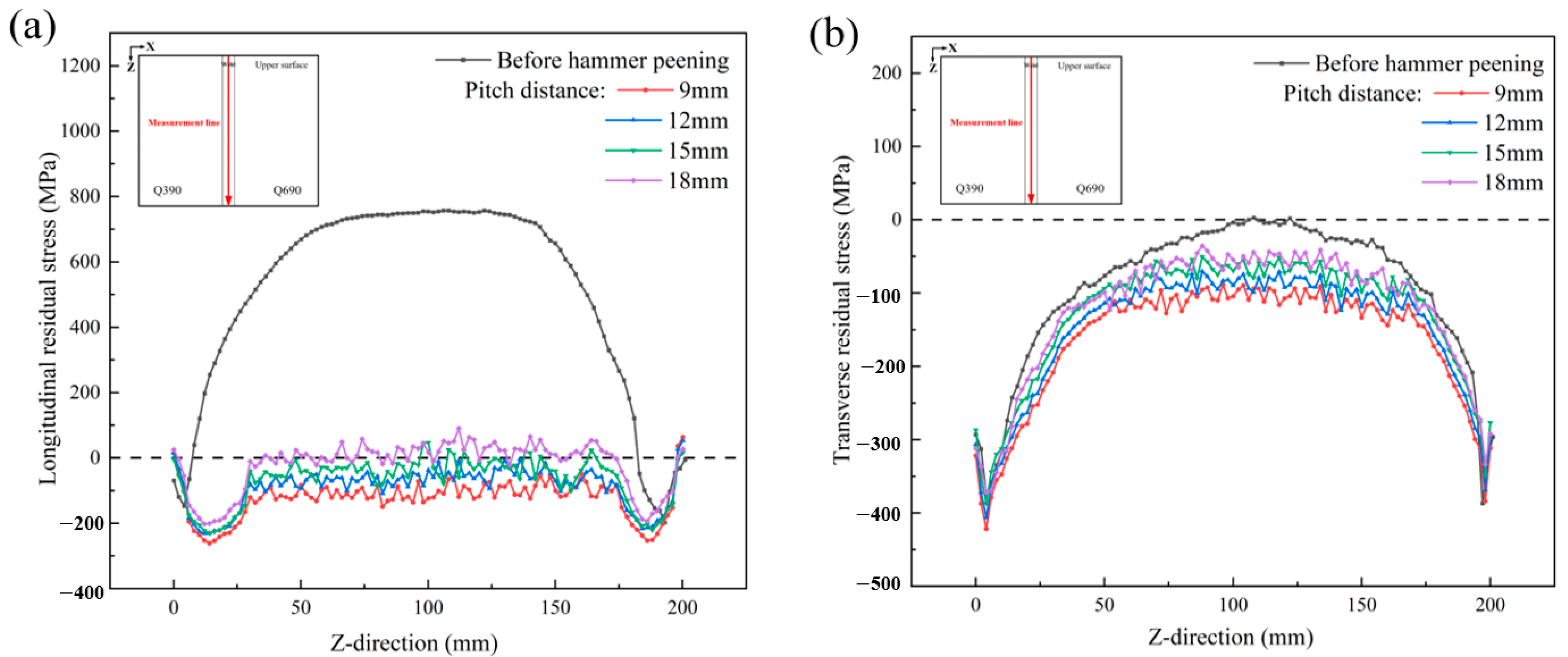

| Material | C | Mo | Mn | P | S | V | Nb | Ni | Cr | Ti | Si | Cu |
|---|---|---|---|---|---|---|---|---|---|---|---|---|
| Q390 | 0.160 | 0.008 | 1.360 | 0.012 | 0.009 | 0.039 | 0.028 | 0.010 | 0.01 | - | - | - |
| Q690 | 0.149 | 0.115 | 1.220 | 0.019 | 0.005 | 0.001 | - | - | 0.19 | 0.015 | 0.24 | - |
| ER76-1 | 0.090 | 0.550 | 1.400 | 0.010 | 0.010 | - | - | 2.60 | 0.50 | 0.100 | 0.20~0.55 | 0.25 |
| Material | Young’s Modulus (GPa) | Yield Strength (MPa) | Tensile Strength (MPa) | Elongation at Break (%) |
|---|---|---|---|---|
| Q390 | 202 | 426 | 561 | 32 |
| Q690 | 202 | 775 | 819 | 17 |
| ER76-1 | - | ≥660 | ≥760 | ≥15 |
| Groove Type | Layer No. | Welding Current I/A | Welding Voltage U/V | Welding Velocity v (mm/s) | Welding Heat Input Q (kJ/mm) |
|---|---|---|---|---|---|
| V-groove | 1 | 150 | 20 | 3 | 0.85 |
| 2 | 180 | 22 | 3 | 1.12 | |
| 3 | 200 | 23 | 3 | 1.30 | |
| 4 | 220 | 25 | 3 | 1.56 |
Disclaimer/Publisher’s Note: The statements, opinions and data contained in all publications are solely those of the individual author(s) and contributor(s) and not of MDPI and/or the editor(s). MDPI and/or the editor(s) disclaim responsibility for any injury to people or property resulting from any ideas, methods, instructions or products referred to in the content. |
© 2025 by the authors. Licensee MDPI, Basel, Switzerland. This article is an open access article distributed under the terms and conditions of the Creative Commons Attribution (CC BY) license (https://creativecommons.org/licenses/by/4.0/).
Share and Cite
Hu, Z.; Shi, E.; Cui, Y.; Hu, J.; Lan, L. Distribution of Residual Stresses in Dissimilar Ferritic Steel Weld Joints and Their Modification via Mechanical Hammer Peening. Metals 2025, 15, 961. https://doi.org/10.3390/met15090961
Hu Z, Shi E, Cui Y, Hu J, Lan L. Distribution of Residual Stresses in Dissimilar Ferritic Steel Weld Joints and Their Modification via Mechanical Hammer Peening. Metals. 2025; 15(9):961. https://doi.org/10.3390/met15090961
Chicago/Turabian StyleHu, Zhiyong, Enyu Shi, Yanan Cui, Jiexin Hu, and Liangyun Lan. 2025. "Distribution of Residual Stresses in Dissimilar Ferritic Steel Weld Joints and Their Modification via Mechanical Hammer Peening" Metals 15, no. 9: 961. https://doi.org/10.3390/met15090961
APA StyleHu, Z., Shi, E., Cui, Y., Hu, J., & Lan, L. (2025). Distribution of Residual Stresses in Dissimilar Ferritic Steel Weld Joints and Their Modification via Mechanical Hammer Peening. Metals, 15(9), 961. https://doi.org/10.3390/met15090961







